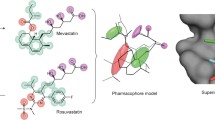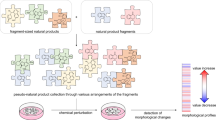Abstract
Natural product analogs are significant sources for therapeutic agents. To capitalize efficiently on the effective features of naturally occurring substances, a natural product-based library production platform has been devised at Aurigene for drug lead discovery. This approach combines the attractive biological and physicochemical properties of natural product scaffolds, provided by eons of natural selection, with the chemical diversity available from parallel synthetic methods. Virtual property analysis, using computational methods described here, guides the selection of a set of natural product scaffolds that are both structurally diverse and likely to have favorable pharmacokinetic properties. The experimental characterization of several in vitro ADME properties of twenty of these scaffolds, and of a small set of designed congeners based upon one scaffold, is also described. These data confirm that most of the scaffolds and the designed library members have properties favorable to their utilization for creating libraries of lead-like molecules.
Similar content being viewed by others
Abbreviations
- ADME:
-
absorption-distribution-metabolism-excretion
- BCUT:
-
Burden-Chemical Abstract Services–University of Texas
- DMSO:
-
dimethylsulfoxide
- e-ADME:
-
early ADME
- HPLC/UV:
-
high performance liquid chromatography monitored by ultraviolet absorbance
- LC-MS:
-
liquid chromatography–mass spectrometry
- MDCK:
-
Madin-Darby canine kidney
- NCI:
-
National Cancer Institute
- PBS:
-
phosphate buffered saline
- PSA:
-
polar surface area
- TEER:
-
transepithelial electrical resistance
References
Samuelsson, G., Drugs of natural origin, Swedish Pharmaceutical Society, Stockholm, Sweden, 1991.
Buss, A.D., Cox, B. and Waigh, R.D., Natural products as leads for new pharmaceuticals, In Abraham, D.J. (Ed), Burger’s Medicinal Chemistry and Drug Discovery, Sixth Edition, Vol. 1, Wiley Interscience, New York, 2003, pp. 847–900.
Newman, D.J., Cragg, G.M. and Snader, K.M., Natural products as sources of new drugs over the period 1981–2002, J. Nat. Prod., 66 (2003) 1022–1037.
Feher, M. and Schmidt, J.M., Property distributions: Differences between drugs, natural products, and molecules from combinatorial chemistry, J. Chem. Inf. Comput. Sci., 43 (2003) 218–227.
Henkel, T., Brunne, R.M., Muller, H. and Reichel, F., Statistical investigation into the structural complementarity of natural products and synthetic compounds, Angew. Chem. Int., 38 (1999) 643–647.
Rouhi, A.M., Rediscovering natural products, Chem. Eng. News, 81 (2003) 77–91.
Rouhi, A.M., Betting on natural products for cures, Chem. Eng. News, 81 (2003) 93–103.
Rouhi, A.M., Moving beyond natural products, Chem. Eng. News, 81 (2003) 104–107.
Urizar, N.L. and Moore, D.D., Gugulipid: A natural cholesterol-lowering agent, Annu. Rev. Nutr., 23 (2003) 303–313.
Urizar, N.L., Liverman, A.B., Dodds, D.T., Silva, F.V., Ordentlich, P., Yan, Y., Gonzalez, F.J., Heyman, R.A., Mangelsdorf, D.J. and Moore, D.D., A natural product that lowers cholesterol as an antagonist ligand for FXR, Science, 296 (2002) 1703–1706.
van de Waterbeemd, H. and Gifford, E. ADMET in silico modelling: Towards prediction paradise? Nat. Rev. Drug. Discov., 2 (2003) 192–204.
Kennedy, T., Managing the drug discovery/development interface, Drug Discov. Today, 2 (1997) 436–444.
Stoner, C.L., Cleton, A., Johnson, K., Oh, D.M., Hallak, H., Brodfuehrer, J., Surendran, N. and Han, H.K., Integrated oral bioavailability projection using in vitro screening data as a selection tool in drug discovery, Int. J. Pharm., 268 (2004) 241-249.
Yu, H., and Adedoyin, A., ADME-Tox in drug discovery: Integration of experimental and computational technologies, Drug Discov. Today, 8 (2003) 852–861.
Crespi, C.L., Miller, V.P. and Stresser, D.M., Design and application of fluorometric assays for human cytochrome P450 inhibition, Methods Enzymol., 357 (2002) 276–284.
Pearlman, R.S. and Smith, K.M., Metric validation and the receptor-relevant subspace concept, J. Chem. Inf. Comput. Sci., 39 (1999) 28–35.
Diverse Solutions Users Manual version 3.0.1: Laboratory of Molecular Graphics and Theoretical Modeling, University of Texas, Austin,Texas copyrighted 1996, 1997, Distributed by Tripos Inc., 1699 S. Hanley Road, St. Louis, MO 63144 (1996, 1997).
Mason, J.S., Absolute versus relative similarity and diversity, In Dean, P.M., and Lewis, R.A. (Eds) Molecular Diversity in Drug Design, Kluwer Academic Publishers, Dordrecht (1999), pp.88-90.
Holliday, J.D., Ranade, S.S. and Willett, P., A fast algorithm for selecting sets of dissimilar molecules from large chemical databases, Quant. Struct.-Act. Relat., 14 (1995) 501–506.
Lipinski, C.A., Drug-like properties and the causes of poor solubility and poor permeability, J. Pharmacol. Toxicol. Methods, 44 (2000) 235–249.
Veber, D.F., Johnson, S.R., Cheng, H.Y., Smith, B.R., Ward, K.W. and Kopple, D.K., Molecular properties that influence oral bioavailability of drug candidates, J. Med. Chem., 45 (2002) 2615–2623.
Irvine, J.D., Takahashi, L., Lockhart, K., Cheong, J., Tolan, J.W., Selick, H.E. and Grove, J.R., MDCK (Madin-Darby canine kidney) cells: A tool for membrane permeability screening, J. Pharm. Sci., 88 (1999) 28–33.
Iwatsubo, T., Hirota, N., Ooie, T., Suzuki, H., Shimada, N., Chiba, K., Ishizaki, T., Green, C. E., Tyson, C.A. and Sugiyama, Y., Prediction of in vivo drug metabolism in the human liver from in vitro metabolism data. Pharmacol. Ther., 73 (1997) 147–171.
Mandagere, A.K., Thompson, T.N. and Hwang, K.K., Graphical model for estimating oral bioavailability of drugs in humans and other species from their Caco-2 permeability and in vitro liver enzyme metabolic stability rates, J. Med. Chem., 45 (2002) 304-311.
Palm, K., Stenberg, P., Luthman, K. and Artursson, P., Polar molecular surface properties predict the intestinal absorption of drugs in humans, Pharm. Res., 14 (1997) 568–571.
Clark, D.E., Rapid calculation of polar molecular surface area and its application to the prediction of transport phenomena. 1. Prediction of intestinal absorption, J. Pharm. Sci., 88 (1999) 807-814.
Yan, Z. and Caldwell, G.W., Metabolism profiling, and cytochrome P450 inhibition and induction in drug discovery, Curr. Top. Med. Chem., 1 (2001) 403–425.
Author information
Authors and Affiliations
Corresponding author
Additional information
These authors have contributed equally to this work.
Rights and permissions
About this article
Cite this article
Samiulla, D., Vaidyanathan, V.V., Arun, P.C. et al. Rational selection of structurally diverse natural product scaffolds with favorable ADME properties for drug discovery. Mol Divers 9, 131–139 (2005). https://doi.org/10.1007/s11030-005-1297-7
Received:
Accepted:
Issue Date:
DOI: https://doi.org/10.1007/s11030-005-1297-7




